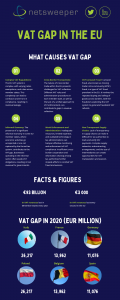Value Added Tax (VAT) plays a vital role in the revenue generation of European Union (EU) member states. VAT lost in the EU refers to the gap between the expected VAT revenue and the actual amount collected by tax authorities. While the exact figure is challenging to determine, estimates suggest that the amount lost in uncollected VAT within the EU is substantial, running into billions of euros annually.
Apart from the obvious revenue losses, it also has other significant implications for EU member states. It hampers their ability to fund public services, invest in infrastructure, and meet budgetary requirements. Moreover, it creates an uneven playing field, as compliant businesses bear a disproportionate burden, while non-compliant entities gain an unfair advantage. Efforts are underway to tackle the VAT gap, including ways governments can improve VAT collection through enforcement measures and implementing effective collection strategies where lacking.
The Magnitude of VAT Losses in the EU
According to the 2022 Report on the VAT Gap released by the European Commission, EU Member States lost an estimated €93 billion in VAT revenues in 2020. Although that number has dropped €31 billion compared to 2019 figures, it continues to be a significant issue, particularly as governments seek reliable revenue sources to navigate the prevailing economic uncertainty. Estimating the precise amount of VAT lost in the EU is complex due to various factors, including the size of the informal economy, non-compliance levels, and the effectiveness of enforcement measures. However, studies and estimates indicate that these losses amount to billions of euros annually, posing a significant economic challenge for EU member states.
Strategies to Enhance VAT Collection
Strategies to enhance VAT collection are essential for governments to generate revenue, ensure budgetary stability, promote fairness, combat tax evasion, and foster economic development. By implementing effective measures and improving compliance, governments can optimize revenue collection and create an enabling environment for sustainable economic growth:
- Mandatory registration and compliance: Governments can enforce mandatory VAT registration for businesses above a certain turnover threshold. By ensuring all eligible businesses are registered, authorities can expand the tax base and minimize revenue leakage due to non-compliance.
- Digitalization and electronic reporting: Implementing digital systems for VAT reporting and invoicing facilitates real-time tracking of transactions. This digitized approach minimizes errors and opportunities for tax evasion. Governments can leverage electronic reporting to enhance VAT collection efficiency and accuracy.
- Risk-based audits: Adopting a risk-based approach to audits allows governments to target high-risk sectors or taxpayers with a history of non-compliance. By focusing enforcement efforts where the potential loss of revenue is significant, authorities can optimize their resources and improve VAT collection rates.
- Cross-border collaboration: International cooperation and information sharing among tax authorities are crucial for combating VAT fraud and evasion in cross-border transactions. By exchanging data and coordinating enforcement actions, EU member states can reduce revenue losses caused by illicit activities across borders.
- Penalties and deterrence: To deter non-compliance, governments can impose penalties and sanctions on businesses that evade VAT obligations. Levying fines, charging interest on overdue VAT payments, and pursuing legal action against persistent offenders create a strong deterrent and encourage compliance.

The Cost of Ineffective VAT Collection
Accurately quantifying the exact amount of revenue lost due to ineffective VAT collection in the EU is challenging. However, studies and estimates suggest that the losses are substantial. Factors such as the size of the informal economy, tax compliance levels, enforcement capabilities, and anti-evasion measures influence the magnitude of these losses. Nevertheless, it is widely recognized that improving enforcement measures can significantly reduce revenue leakage and enhance VAT collection.
Netsweeper’s Tax Collection and Remittance Solution is a comprehensive software solution designed to assist governments and tax authorities in enhancing the collection and remittance of taxes, including Value Added Tax (VAT). This solution leverages advanced technology to streamline the tax collection process, improve compliance, and minimize revenue leakage.
Key features of Netsweeper’s Tax Collection and Remittance Solution include:
• The solution utilizes automated data capture mechanisms to collect relevant tax information from businesses, ensuring accuracy and reducing manual errors.
• Netsweeper’s solution enables tax authorities to monitor tax compliance in real time.
• Includes built-in compliance verification tools to ensure that businesses accurately report and remit the appropriate taxes.
• It can integrate with existing tax systems and processes, allowing for a seamless implementation and data exchange.
• Supports auditing and risk assessment activities by providing tools to identify high-risk taxpayers and sectors prone to non-compliance.
• Prioritizes data security and scalability.
For more on this topic, download our Datasheet: Ecommerce Tax Collection and follow us on Twitter and LinkedIn to stay up to date with the latest information.
